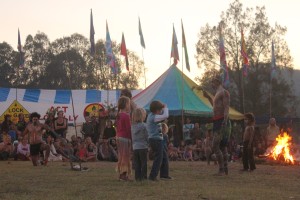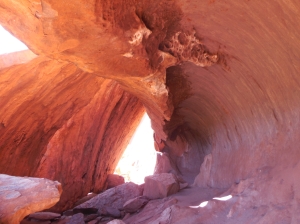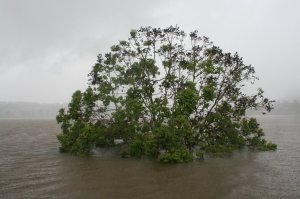
Bunjalung Dancers Taking Us All Into The Dream Time
I had been in the country for 8 days but had yet to experience anything beyond Byron Bay and I was itching to see the country side. My time had been spent figuring out how to join official Australia by registering with the tax office, setting up a bank account and genereally just figuring out how the System worked in this part of the world. But now the time had finally come to get my shirt dirty and go into the bush.
My amazing new friend Rad (see Remarkable Encounters) had asked me if I wanted to join her in going to a so-called Rainbow Corroboree where Aboriginals from the region would be sharing some of their sacred dances with whoever felt like joining the event. Having always been fascinated with Aboriginal culture, and knowing how rare it was for white folks to be included in their ceremonies, I obviously jumped at the opportunity with great excitement, even without really knowing what I was getting into.
Into The Bush
When Rad pulled into the parking lot at the Arts Factory, it was the first time we had seen each other since we had initally met in India, some 5 months before. I was thrilled to be able to thank her in person with a great big hug for the support she had given me in Australia already.
I was also thrilled to see her daughters again, the lovely Saisha and Pad, who are among the wisest and most grounded kids I have ever met. After a good long hugging session, we all climbed into Rad’s ancient and beautifully decorated campervan, cranked up some mellow reggae and got rolling into the hinterland of Northern New South Wales – on the way to a most unusual meeting of cultures.
Climbing up and down the steep hills towards the heartland of Bunjalung culture, the tiny village of Tabulam, Rad told me more about the Rainbow Corroboree – also called “Julinbah Yowarl” by the indigenous Bunjalung Nation who refer to their land as the Rainbow Region.
It turned out that this was more than just a display of Aboriginal culture to uninitiated spectators: This festival was going to be a gathering of people who were eager and willing to share their arts and their beliefs across the vast gap between Aboriginal and White Australia. Not only was I going to experience the Bunjalung’s sacred dances first hand, I was also going to meet hundreds of hippies, travellers and like-minded people. It seemed that I had struck a golden ore less than two weeks into my trip!
Prophecy Come True
The Julinbah Yowarl was started 4 years ago by a group of white Australians – who were more than just sympathetic towards the rights of Aboriginals – and a group of Bunjalung Elders and their much respected prodigy Uncle Lewis.
To my understanding, Uncle Lewis has been chosen as the keeper and custodian of the local Bunjalung myths and legends, also known as songlines, and according to a Bunjalung Rainbow profecy the time has now come for the Bunjalung People to share their ancient wisdom with the rest of the world.
As we drove through the gate to Uncle Lewis’ huge property outside of Tabulam, 5-year-old Padma took over the wheel, sitting on her mother’s lap, while we tried to figure out which of the handful of dirt tracks in front of us would lead to the festival-site.
I’ve never seen a 5-year-old steer a car so competently (and stubbornly), and with everybody’s eyes on the road we found our way over a broad field and through the forest to a gorgeous meadow bordering a clear and sparkling river: We had finally arrived at the forefront of the ongoing reconciliation process between white and black Australians.
Far from the bushy-faced, Santa-Claus-bodied image I had conjured, Uncle Lewis was as lean a warrior as I’ve ever seen, with a sharply defined and designed beard, long shiny black hair and rope-like muscles bulging under his deep brown skin as he hammered in the last peg of the Children’s Tent.
“Jingiwala brother, heuw ya goin?” he addressed me as I rocked up to the site to offer my help. When he heard I’d come from the other side of the planet, he shook my hand and thanked me with a “booglebare” and his dark and intense eyes. He told me to start doing whatever I felt like doing.
Setting Up With The Go-To-Guys
We’d arrived a day early and on the main site you could hardly tell there was going to be a festival happening only 24 hours later. But just a 3-minute walk down the riverside there were already a small temporary village of elaborate camper vans, home-made teepees, tents and improvised shelters.
These were all full-time modern Australian hippie-gypsies it seemed, humans whose nomadic lifestyles and spiritual searches had brought them here several days early and most likely would only leave several days after the event was over.
I quickly got head-hunted to rig up a sun-shelter for the Elders of the local Bunjalung tribe. It was the gentle and hard-working Sky who gave me the honourable task. Sky is a Polish force of nature who immigrated to Australia more than 30 years ago, protesting the Communist regime in his native land and dodging the compulsary military service that would have sent him fighting into Afghanistan.
Some years ago, Sky and a few others had gotten to know some of the Bunjalung Elders of the area as well as Uncle Lewis. Together they had envisioned the Rainbow Corroboree which is now taking place twice a year at the time of equinox.
Somehow I had managed to get to know the main organizers of the Rainbow Corroboree within a few hours of arriving at the event, and I was feeling grateful to the point where I hardly knew where to channel my emotions.
After a long, hot and happy day, working away with the dedicated crew, I returned to the spot where Rad had put her van next to the river. On the way I enjoyed the setting sun behind the rolling hills and the eucalyptus and iron-bark forest, and the rising smoke from the many bonfires with laughing, cooking, singing and sleeping people sprawled around them – life was good!
Family Is All Around
The next morning I decided to give the guys from the Rainbow Chai Tent a hand. As soon as they heard I was from Christiania they treated me like a long lost friend. One had been there and loved it, another one had heard about it and was curious to know more and a third one used be with the girl who painted the famous mural by the entrance of Christiania: “She must be an old woman by now” he laughed and tried to imagine if she would be as beautiful as he remembered her. There was no doubt, I was among family.
As I made my way around the small festival area, lending a hand to whoever needed it, I rapidly made new friends from all over the world. With the scorching sun baking down on us from a clear blue sky, more and more camper vans and 4-wheel-drives came cravling over the hill and eventually the first band started playing from the main stage (the only one) and finally the festival was on.
Whenever one felt drained from the heat, the refreshing river was only a short change of clothes away. It was so clean that many of us drank straight from it, enjoying the beneficial effects of the water which apparently contains a small amount of colloidal gold!
Dancing In Dream Time
By sunset, most of us gathered around a great big bunfire where the festival’s daily highlight was about to commence for the first time: A corroboree is an indigenous Australian word for a performance which lies somewhere in between theatre and ceremony. I had heard that it was quite difficult to join a corroboree if you weren’t Aboriginal, so it was with immense anticipation that I watched my first corroboree unfold.

These kids just spontaneously walked into the circle and created a small but powerful moment in Australia’s history.
Once a big circle of people had formed and a hush had fell over the crowd, Uncle Lewis stood up in the middle and welcomed us all, clearly moved by the interest and diversity of everyone there. Then the dances began, all accompanied by a didjeridoo-player (I thought I’d heard good didj-players before…).
Then came a series of dances dedicated to the various totem-animals of the Bunjalung People with the most prominent being the “Guruman” – or as we know it – the kangaroo. So life-like were the performances that the dancers seemed taken over by the spirit of the Guruman and its fellow creatures.
There were also dances that re-enacted different everyday practices such as collecting mussles and picking berries, not to mention a heart-wrenching performance showing us the first encounter between Bunjalung People and European Settlers.
It is said that during a corroboree, the dancers interact with the “Dreamtime”. I can safely say that during the corroborees, which took place every evening of the festival, everyone present seemed transported into a living dream.
During the very last dance of the very last corroboree, Uncle Lewis invited everyone to join in for a final cleansing dance. Needless to say, I jumped at the opportunity to become a part of Aboriginal culture, if only for a single dance. Afterwards I felt both elated and proud and it was definitely a highlight on my Australian journey so far!
Corroboree Connections
Throughout the festival – the biggest one held so far – I made friends with too many great humans to mention here, but I’m sure you will hear of many of them later on, as I made enough connections to keep me busy for a good while as I explore the area around Nimbin, a hub for Australia’s counter-culture and home to thousands of like-minded hippies, artists, gypsies and wisdom-seekers.
I had so many golden moments that I am even struggling to remember them all as I write this. I cannot possibly thank my angel-friend Rad enough for inviting me to this incredibly beautiful festival – an event that started my journey through the spiritual realms of Australia and which I am sure will keep returning to me both in memory and through all the connections I made there.
Thank you Uncle Lewis and your crew and thank you Australia!!!










